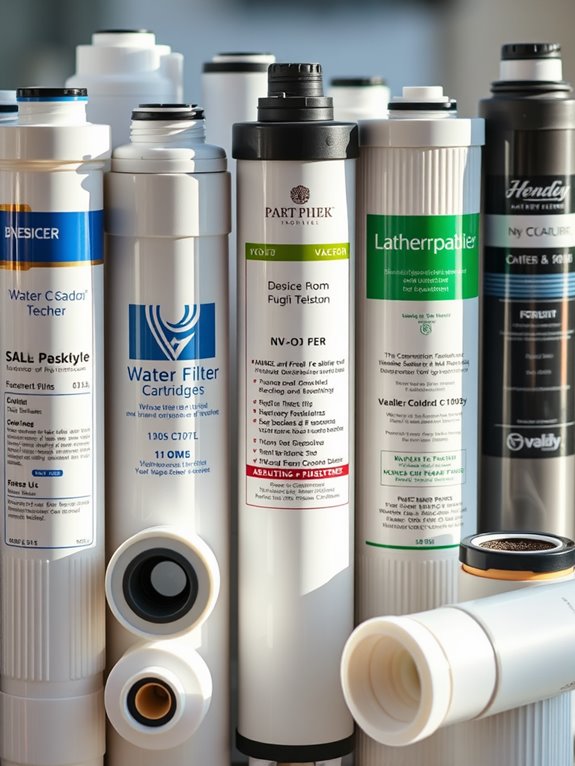Water filter cartridges aren’t universally interchangeable, so it’s essential you check compatibility with your filtration system. Each cartridge type—like activated carbon or reverse osmosis—has specific dimensions and connections that need to match your system. Using the wrong cartridge can cause leaks and reduce filtration quality. Always consult your manufacturer’s specifications for the right fit. Understanding these details can help you maintain clean, safe drinking water. There’s much more to explore about this topic ahead!
Understanding Water Filter Cartridges

When you start exploring water filter cartridges, it’s essential to understand their role in providing clean drinking water.
These cartridges trap contaminants, guaranteeing impurities like chlorine, sediments, and heavy metals don’t enter your glass. They enhance taste and safety, making your water healthier and more enjoyable.
You’ll find various cartridges designed for different filtration methods, like activated carbon or reverse osmosis. Knowing how these cartridges function helps you choose the right one for your needs.
Regular replacement is key to maintaining water quality, so stay on top of your filter schedule to make sure you’re always drinking the best water possible.
Types of Water Filter Cartridges
When choosing a water filter cartridge, you’ll encounter various types, each designed for specific filtration needs.
Understanding common cartridge types and their compatibility with your system is essential for effective water purification.
Let’s explore these options to help you make informed decisions.
Common Cartridge Types
Water filter cartridges come in various types, each designed to tackle specific contaminants and improve your drinking water quality.
Here are four common cartridge types you might encounter:
- Activated Carbon – Great for removing chlorine, taste, and odor.
- Reverse Osmosis – Effective in eliminating heavy metals and dissolved solids.
- Ceramic – Filters out bacteria and sediment for cleaner water.
- Ion Exchange – Reduces hardness and heavy metals by exchanging ions.
Understanding these types helps you choose the right filter for your needs, ensuring you enjoy fresh, clean water every time you fill your glass.
Compatibility Considerations
Choosing the right water filter cartridge isn’t just about knowing the types; compatibility plays an essential role in ensuring best performance. You need to match the cartridge with your filtration system.
Different systems use various sizes, shapes, and connection types, so always check your manufacturer’s specifications. Using an incompatible cartridge can lead to leaks or inadequate filtration.
Don’t assume that all cartridges labeled for a specific type will fit your system; they may differ in design. To avoid issues, stick to the recommended brands or models for your filter, and consult your user manual for guidance on compatibility.
You might also be interested in: Are All Water Filters the Same? Understanding the Key Differences
Compatibility Between Brands

Although many water filter cartridges may look similar, compatibility between brands can vary considerably.
It’s essential to check if your cartridge will work with your system. Here are some things to keep in mind:
- Brand Specifications: Always refer to the manufacturer’s guidelines for compatibility.
- Model Numbers: Different models, even within the same brand, may require specific cartridges.
- Filter Type: Some brands use proprietary designs that won’t fit others.
- Performance Standards: Verify the cartridge meets filtration standards for your system.
Taking these aspects into account can save you time and money when replacing your water filter cartridge.
Key Factors Affecting Interchangeability
Understanding compatibility between brands is just the beginning; several key factors influence whether water filter cartridges can be interchanged.
First, consider the size and shape of the cartridge, as mismatches can prevent proper installation.
Next, look at the filtration technology used—different systems may require specific types of filters to function effectively.
The flow rate is another essential factor; using a cartridge with a different flow rate can affect water pressure and quality.
Finally, check the manufacturer’s specifications, as they often provide guidance on compatible cartridges.
All these elements play an important role in ensuring you get the best performance from your filter system.
Benefits of Using Compatible Cartridges

When you opt for compatible cartridges, you often experience improved efficiency and performance from your water filtration system.
Here are some benefits you’ll enjoy:
- Cost Savings: Compatible cartridges usually cost less than brand-name options, helping you save money.
- Easy Availability: You can find compatible cartridges in various online and local stores, making restocking hassle-free.
- Environmental Impact: Many compatible options are made from eco-friendly materials, reducing environmental harm.
- Compatibility: They’re designed to fit multiple systems, ensuring your filtration remains effective without the need for brand-specific products.
Switching to compatible cartridges is a smart choice!
Risks of Mixing Different Cartridges
Mixing different water filter cartridges can lead to compatibility issues that compromise your filtration system.
You might find that the combined effectiveness in contaminant removal drops considerably, putting your water quality at risk.
It’s essential to guarantee that the cartridges you’re using work well together to maintain peak performance.
Compatibility Issues
While it might seem convenient to swap out different water filter cartridges, doing so can lead to serious compatibility issues. Mixing cartridges can disrupt your system’s performance and even compromise your water quality.
Here are some risks you might face:
- Reduced filtration efficiency – Different cartridges may filter contaminants at varying levels.
- Increased leaks – Mismatched sizes can lead to improper seals, causing leaks.
- Shortened lifespan – Using incompatible cartridges can wear out your filter system faster.
- Warranty void – Mixing cartridges might void any warranties on your filtration system.
Stick to the same brand and type for best results!
Contaminant Removal Efficiency
Swapping out different water filter cartridges can greatly impact the system’s ability to remove contaminants effectively.
When you mix cartridges, you might compromise the filtration process, leading to inadequate purification. Each cartridge is designed to target specific contaminants, and combining them can result in unexpected interactions. This means harmful substances could slip through, posing health risks.
It’s essential to stick with compatible filters to guarantee maximum efficiency. Always check the manufacturer’s recommendations before making any changes.
Your health depends on clean water, so don’t take shortcuts when it comes to your filtration system. Choose wisely for ideal contaminant removal.
How to Identify Cartridge Specifications

To effectively identify cartridge specifications, you should start by checking the model number and compatibility details provided by the manufacturer. This guarantees you’re selecting the right cartridge for your system.
Here are a few key aspects to take into account:
- Dimensions: Measure the length and diameter of the cartridge.
- Filter Type: Identify whether it’s activated carbon, reverse osmosis, or another type.
- Flow Rate: Check how much water the cartridge can filter per minute.
- Lifespan: Look for the recommended replacement frequency to maintain efficiency.
Understanding these factors will help you select the right cartridge confidently.
Maintenance Tips for Water Filter Systems
To keep your water filter system running smoothly, regular cartridge replacement is essential.
You should also clean and sanitize your system periodically to prevent any buildup.
These simple maintenance tips can considerably enhance the performance and longevity of your water filter.
Regular Cartridge Replacement
Regularly replacing your water filter cartridges is essential for maintaining clean and safe drinking water. Neglecting this task can lead to bacteria buildup and decreased filtration efficiency.
To keep your system running smoothly, follow these maintenance tips:
- Set a Schedule: Mark your calendar for replacement dates based on usage.
- Check Indicator Lights: Many systems have alerts; pay attention to them!
- Keep Spares Handy: Always have extra cartridges on hand for quick replacements.
- Follow Manufacturer Guidelines: Stick to the recommended replacement frequency for best performance.
Cleaning and Sanitizing System
After ensuring your water filter cartridges are replaced on schedule, the next step is cleaning and sanitizing your system.
Start by turning off the water supply and unplugging the unit. Remove any components according to the manufacturer’s guidelines.
Use a mixture of vinegar and water or a mild bleach solution to wipe down surfaces. Rinse thoroughly to avoid any residue.
Don’t forget to clean the reservoir and any other parts that come into contact with water.
Once everything’s dry, reassemble the system, restore the water supply, and run water through it for a few minutes before using.
Regular maintenance keeps your water pure!
Cost Considerations for Replacement Cartridges

When considering replacement cartridges for your water filter, cost is a pivotal factor that can greatly influence your decision.
You’ll want to keep these points in mind:
- Initial Investment: Some filters may have low-cost cartridges but higher upfront costs.
- Frequency of Replacement: More frequent changes can add up over time.
- Brand Variability: Prices can differ considerably between brands, so do your research.
- Long-term Savings: Sometimes, pricier cartridges offer better filtration and longer life, saving you money in the long run.
Budget wisely to guarantee you get the best value for your clean water needs!
When to Replace Your Water Filter Cartridge
How can you guarantee your water filter is performing at its best? Regularly replacing your water filter cartridge is key.
Most cartridges need replacement every six months, but it varies based on usage and water quality. If you notice a change in taste, odor, or flow rate, it’s time to swap it out.
Additionally, check for any manufacturer recommendations and keep an eye on indicators if your system has them.
By staying proactive about replacements, you’ll guarantee clean, safe drinking water and prolong the lifespan of your filtration system.
Don’t wait until problems arise—replace your cartridge on schedule!
Conclusion
In the world of water filtration, think of your cartridge as the heart of the system; without the right fit, everything can falter. While some cartridges may seem interchangeable, it’s vital to choose wisely to guarantee peak performance. By understanding compatibility and specifications, you can quench your thirst for clean water without worry. So, keep your system humming smoothly, and remember: the right cartridge isn’t just a convenience; it’s the lifeblood of your hydration journey.

I’m Allen Kim, the chief editor of plumbinginto. I am a mid level plumber and assign to an local firm over 4 years of experience. During the working period, most of my experience is related to the house plumbing. I learned about the thing, when working with most experienced people in this sector, one must be as good as the inspector or better with knowledge of the project as well as the practical aspects of plumbing industry.